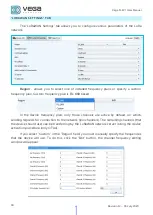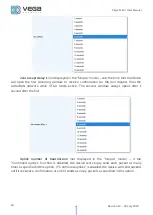
Vega SI-12 / User Manual
5
Revision 12 – 03 July 2020
1 DESCRIPTION AND OPERATION
DEVICE DESCRIPTION
Vega SI-12 pulse counter is designed for counting of pulses incoming to 4 independent
inputs, further accumulating and transmitting of this information to the LoRaWAN network.
In addition, Vega SI-12 can be used as a security device - all inputs can be configured as
security inputs.
The counter has two open-collector digital outputs and can be used as a control
device.
The pulse counter can be used for any utilities’ meters and industrial equipment with
pulse output of herkon type or open-drain type.
Equipment with NAMUR pulse output is not supported
De-bouncing logics with 5 msec time constant is integrated in the pulse counter. The
pulse counting is carried out for frequencies up to 200 Hz.
The counter is powered by a 3400 mAh built-in battery. The counter also can be
powered by the 5V external power supply.
The device is powered by a non-rechargeable lithium-thionyl chloride
(LiSOCl
2
) battery
Attempts to charge the battery may result in fire
COMUNICATION AND DATA COLLECTION ALGORITHM
The readings collecting from the meter with a configurable period from 5 minutes to
24 hours. The readings stored in the device memory and transmitting during the next
communication session with the LoRaWAN network.
The adjustable data transfer period can be from 5 minutes to 24 hours. Data
transferring in random point in time during set period. At the next communication session, the
device starts sending accumulated packets with readings, from the earliest to the latest.
With the "Confirmed uplinks" option turned on, the device will send the next packet
only after receiving a confirmation of the delivery of the previous one. If such confirmation
has not received after the fulfilled in the settings uplink number of transmissions, device
completes the communication session until the next one according to the schedule. In this
case, the device continues to collect data according to the data collection period and store it
in memory. Non-transmitted packets remain in the device memory until the next
communication session.
































